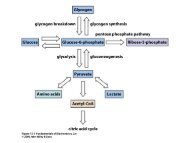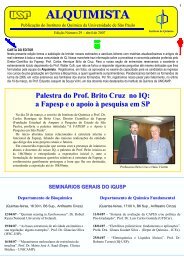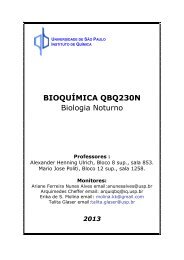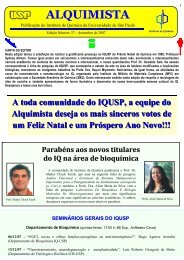Studies on PVP hydrogel-supported luminol ... - ResearchGate
Studies on PVP hydrogel-supported luminol ... - ResearchGate
Studies on PVP hydrogel-supported luminol ... - ResearchGate
Create successful ePaper yourself
Turn your PDF publications into a flip-book with our unique Google optimized e-Paper software.
Luminescence (In press)Published Calibrati<strong>on</strong> <strong>on</strong>line analytical in Wiley applicati<strong>on</strong>s InterScience studies (www.interscience.wiley.com) <strong>on</strong> <strong>PVP</strong> <strong>hydrogel</strong>-<strong>supported</strong> DOI: <strong>luminol</strong> 10.1002/bio.935CL ORIGINAL RESEARCH ORIGINAL RESEARCH1ORIGINAL RESEARCH<str<strong>on</strong>g>Studies</str<strong>on</strong>g> <strong>on</strong> <strong>PVP</strong> <strong>hydrogel</strong>-<strong>supported</strong> <strong>luminol</strong>chemiluminescence: 2. Luminometer calibrati<strong>on</strong> andpotential analytical applicati<strong>on</strong>sErick Leite Bastos, 1 Luiz Francisco M<strong>on</strong>teiro Leite Ciscato, 1 Fernando Heering Bartol<strong>on</strong>i, 1 LuizHenrique Catalani, 1 Paulete Romoff 2 and Wilhelm Josef Baader 1 *1Instituto de Química, Universidade de São Paulo, Av. Prof. Lineu Prestes 748, 05508-900 São Paulo, SP, Brazil2 Faculdade de Ciências Biológicas, Exatas e Experimentais, Universidade Presbiteriana Mackenzie, Rua da C<strong>on</strong>solação 896, 01302-907 São Paulo, SP, BrazilReceived 27 March 2006; revised 16 May 2006; accepted 17 May 2006ABSTRACT: The use of poly(N-vinyl-2-pyrrolid<strong>on</strong>e) (<strong>PVP</strong>) <strong>hydrogel</strong>-<strong>supported</strong> <strong>luminol</strong> chemiluminescence (CL) for the automaticdeterminati<strong>on</strong> of hydrogen peroxide and the quantificati<strong>on</strong> of the antiradical capacity of Trolox is described. The <strong>hydrogel</strong>c<strong>on</strong>taining <strong>luminol</strong> and hemin is prepared directly <strong>on</strong> a 96-well microplate and can be stored for up to 3 m<strong>on</strong>ths without significantdecrease in CL quantum yields. Furthermore, this system can also be used as a sec<strong>on</strong>dary light standard for the calibrati<strong>on</strong> ofmicroplate luminometers. Copyright © 2006 John Wiley & S<strong>on</strong>s, Ltd.KEYWORDS: <strong>PVP</strong>; <strong>luminol</strong>; antiradical; hydrogen peroxide; luminometer calibrati<strong>on</strong>INTRODUCTIONThe chemiluminescence (CL) of <strong>luminol</strong> (Scheme 1) canbe induced by free radical and/or redox processes andthe simplicity and sensitivity of this technique is used toadvantage in the development of analytical methods forthe m<strong>on</strong>itoring of free radical producti<strong>on</strong> or c<strong>on</strong>sumpti<strong>on</strong>(1–5). In recent years, a series of <strong>luminol</strong>-basedanalytical methods <strong>on</strong> alternative supports has been proposedto detect hydrogen peroxide directly or substrateswhich can be c<strong>on</strong>verted to it. In additi<strong>on</strong>, reductantshave also been quantified by these systems which, inmost cases, are used as remote chemical sensors (6–9).In CL assays, the oxidati<strong>on</strong> of a specific substrateresults in the formati<strong>on</strong> of a high-energy intermediatewhich is transformed into an electr<strong>on</strong>ically excitedproduct, resp<strong>on</strong>sible for light emissi<strong>on</strong> up<strong>on</strong> decay toits ground state. The CL reagents can be incorporatedinto flow-injecti<strong>on</strong> analysis systems, but this demandssignificant amounts of reagents and, c<strong>on</strong>sequently,increased residue producti<strong>on</strong>. The incorporati<strong>on</strong> of CLreagents and/or catalysts (e.g. dehydrogenases,peroxidases, oxidases, hemin) within <strong>hydrogel</strong>s andpolymeric thin films for the detecti<strong>on</strong> of inorganic and*Corresp<strong>on</strong>dence to: W. J. Baader, Instituto de Química, Universidadede São Paulo, Av. Prof. Lineu Prestes 748, 05508-900 São Paulo, SP,Brazil.E-mail: wjbaader@iq.usp.brC<strong>on</strong>tract/grant sp<strong>on</strong>sor: FAPESP, Brazil; C<strong>on</strong>tract/grant number:98/05445-9; 00/06652-0; 01/07477-0.C<strong>on</strong>tract/grant sp<strong>on</strong>sor: CNPq, Brazil.C<strong>on</strong>tract/grant sp<strong>on</strong>sor: CAPES, Brazil.C<strong>on</strong>tract/grant sp<strong>on</strong>sor: PADCT, Brazil.Copyright © 2006 John Wiley & S<strong>on</strong>s, Ltd.Scheme 1.CL oxidati<strong>on</strong> of <strong>luminol</strong> in alkaline aqueous media.organic chemicals provides a simple alternative to suchsystems (8–10).Recently we have investigated the CL propertiesof hemin-catalysed <strong>luminol</strong> oxidati<strong>on</strong> by hydrogen peroxidein a <strong>PVP</strong> <strong>hydrogel</strong> matrix. Multivariate factorialanalysis (MFA) was used to quantify the effect ofreagent c<strong>on</strong>centrati<strong>on</strong>s <strong>on</strong> initial emissi<strong>on</strong> intensities(I 0 ), emissi<strong>on</strong> areas (S) and observed decay rate c<strong>on</strong>stants(k obs ). Using this approach, it is possible to accessoptimal experimental c<strong>on</strong>diti<strong>on</strong>s for specific analyticalapplicati<strong>on</strong>s (11).This paper describes the utilizati<strong>on</strong> of the <strong>PVP</strong><strong>supported</strong><strong>luminol</strong>–hemin system (<strong>PVP</strong> <strong>hydrogel</strong> CLsystem) for the calibrati<strong>on</strong> of commercial microplateluminometers and dem<strong>on</strong>strates that this automatedsystem can be used for the determinati<strong>on</strong> of hydrogenperoxide and Trolox, an antiradical standard.MATERIALS AND METHODSReagentsLuminol (5-amino-2,3-dihydro-phthalazine-1,4-di<strong>on</strong>e)was obtained from Merck (Germany) and a stockLuminescence (In press)DOI: 10.1002/bio
ORIGINAL RESEARCHsoluti<strong>on</strong> (10 mmol/L) was prepared in 1 mol/L NaOH,kept at 4°C and used within 10 days. The workingstock soluti<strong>on</strong> was prepared by diluti<strong>on</strong> in phosphatebuffer (0.1 mol/L, Na 3 PO 4 /Na 2 HPO 4 ), pH 11.6. Thefinal <strong>luminol</strong> c<strong>on</strong>centrati<strong>on</strong> was determined spectrophotometricallyat 347 nm (ε = 7600 mol/L/cm).Hydrogen peroxide (Peróxidos do Brasil, Brazil)was obtained as a 60% w/w unstabilized aqueoussoluti<strong>on</strong>. The final c<strong>on</strong>centrati<strong>on</strong> after diluti<strong>on</strong> withdemineralized water (18 MΩ, Milli-Q, Millipore) wasdetermined spectrophotometrically, as described byCott<strong>on</strong> and Dunford (12). Hemin (ferriprotoporphyrinIX chloride) was purchased from Sigma (St. Louis,USA). A stock soluti<strong>on</strong> was prepared by dissolving2.5 mg hemin in 5 mL 1 mol/L aqueous NaOH. Theworking soluti<strong>on</strong> is a 1:100 diluti<strong>on</strong> with 1 mol/L NaOH(8 µmol/L). The c<strong>on</strong>centrati<strong>on</strong> was determined spectrophotometricallyusing ε = 58400 mol/L/cm at 382 nm(13). Poly(N-vinyl-2-pyrrolid<strong>on</strong>e), known as Plasd<strong>on</strong>eK-90 (M w = 1.2· × 10 6 ; M n = 3.6· × 10 5 ), was obtained fromGAF Chem. Co. (USA). Trolox (6-hydroxy-2,5,7,8-tetramethylchroman-2-carboxylic acid) was obtainedfrom Aldrich (Milwaukee, USA) and used as antiradicalstandard.InstrumentsThe CL emissi<strong>on</strong> experiments were performed <strong>on</strong> aBerthold EG&G 96V Lumimat microplate luminometer.Absorpti<strong>on</strong> spectra were recorded using a ShimadzuMultispec 1500 UV-visible spectrophotometer.Preparati<strong>on</strong> of <strong>PVP</strong> <strong>hydrogel</strong> c<strong>on</strong>taining <strong>luminol</strong>and heminAliquots (200 µL) of a soluti<strong>on</strong> c<strong>on</strong>taining 120 mg/mL<strong>PVP</strong> and adequate c<strong>on</strong>centrati<strong>on</strong>s of <strong>luminol</strong> and heminin phosphate buffer (pH 11.6, µ = 0.1 mol/L) were placedin a 96-well microplate, which was positi<strong>on</strong>ed 20 mm distantfrom a pen-type Heraeus (Hanau, Germany) 20 Wlow-pressure Hg lamp (λ em = 254 nm; 200 mm l<strong>on</strong>g). Thesoluti<strong>on</strong> was irradiated for 30 min under a slow flux ofinert gas. The resulting microplates can be used directlyor dried for storage and c<strong>on</strong>tinuous use. For storage, themicroplates were submitted to a slow arg<strong>on</strong> flux until athin film (ca. 2 mm) was formed, packed in PVC film andstored at 4°C.Hydrogen peroxide determinati<strong>on</strong>The freshly prepared 96-well microplate c<strong>on</strong>taining the<strong>PVP</strong> <strong>hydrogel</strong>-<strong>supported</strong> <strong>luminol</strong>–hemin system (<strong>PVP</strong><strong>hydrogel</strong> CL system) was put into the cavity of aluminometer and thermostated to 25.0 ± 0.5°C. The reacti<strong>on</strong>was initiated by automatic jet injecti<strong>on</strong> of 100 µLaqueous hydrogen peroxide soluti<strong>on</strong> in adequateCopyright © 2006 John Wiley & S<strong>on</strong>s, Ltd.E. L. Bastos et al.c<strong>on</strong>centrati<strong>on</strong>. To perform the experiments with storedmicroplates, 200 µL phosphate buffer (pH 11.6, µ =0.1 mol/L) were added to each well prior to placing itinto the luminometer cavity, followed by hydrogen peroxideadditi<strong>on</strong> (100 µL) to initiate the measurement.The results obtained in both cases were very similar andfinal reagent c<strong>on</strong>centrati<strong>on</strong>s were reported for a finalvolume of 300 µL (final c<strong>on</strong>centrati<strong>on</strong>s: <strong>PVP</strong>, 80 mg/mL;<strong>luminol</strong>, 1.0 mmol/L; hemin, 7.7 nmol/L). Emissi<strong>on</strong> decaywas m<strong>on</strong>itored for 1 h in cycles of 60 measurements/well/h.Quantificati<strong>on</strong> of the antiradical effect ofTroloxAliquots (60 µL) of a Trolox soluti<strong>on</strong> in adequatec<strong>on</strong>centrati<strong>on</strong> were added to each well of a microplatec<strong>on</strong>taining 200 µL <strong>PVP</strong> <strong>hydrogel</strong> CL system. Thereacti<strong>on</strong> was initiated by additi<strong>on</strong> of 40 µL aqueous0.75 mmol/L hydrogen peroxide soluti<strong>on</strong> to eachwell, using the automatic jet injecti<strong>on</strong> system presentin the Berthold luminometer (final c<strong>on</strong>centrati<strong>on</strong>s:<strong>PVP</strong>, 80 mg/mL; <strong>luminol</strong>, 1.0 mmol/L; hemin, 7.7 nmol/L; H 2 O 2 , 0.10 mmol/L). Emissi<strong>on</strong> decay was m<strong>on</strong>itoredfor 1 h in cycles of 60 measurements/well/h.Microplate luminometer calibrati<strong>on</strong>Aqueous media calibrati<strong>on</strong>. To a single well of a white96-well microplate thermostated to 25.0 ± 0.5°C, c<strong>on</strong>taining200 µL <strong>luminol</strong> soluti<strong>on</strong> (15.0 nmol/L) in phosphatebuffer (pH 11.6, µ = 0.1 mol/L), 40 µL 75.0 µmol/Laqueous hydrogen peroxide soluti<strong>on</strong> were added byautomatic injecti<strong>on</strong>. The reacti<strong>on</strong> was initiated byadditi<strong>on</strong> of 20 µL hemin soluti<strong>on</strong> (0.8 nmol/L). Aftercomplete emissi<strong>on</strong> decay in about 20 s, 20 µL hemin(2.4 nmol/L) soluti<strong>on</strong> were added and a low-intensityemissi<strong>on</strong> was observed. Finally, an additi<strong>on</strong>al injecti<strong>on</strong>of the c<strong>on</strong>centrated hemin soluti<strong>on</strong> was made (20 µLhemin 2.4 nmol/L), normally not leading to measurablelight emissi<strong>on</strong>, to assure complete <strong>luminol</strong> c<strong>on</strong>sumpti<strong>on</strong>.The final reacti<strong>on</strong> mixture c<strong>on</strong>tains 0.37 nmol/L hemin,10.0 nmol/L <strong>luminol</strong> and 10.0 µmol/L hydrogen peroxidein 300 µL final volume.Hydrogel calibrati<strong>on</strong>. To a single well of a microplatefilled with 240 µL of <strong>PVP</strong> <strong>hydrogel</strong> CL system([<strong>luminol</strong>], 12.5 nmol/L; [hemin], 0.26 nmol/L), 40 µL75.0 µmol/L hydrogen peroxide soluti<strong>on</strong> were addedby automatic injecti<strong>on</strong>. After total emissi<strong>on</strong> depleti<strong>on</strong>,an additi<strong>on</strong>al volume of 20 µL hemin (2.4 nmol/L)soluti<strong>on</strong> was added to the reacti<strong>on</strong> mixture. In theexperimental c<strong>on</strong>diti<strong>on</strong>s utilized, the last hemin additi<strong>on</strong>leads to very low-intensity light emissi<strong>on</strong> and theemissi<strong>on</strong> area was, in all cases tested, less than 5% ofthe initial emissi<strong>on</strong> area. The final reacti<strong>on</strong> mixtureLuminescence (In press)DOI: 10.1002/bio
Calibrati<strong>on</strong> analytical applicati<strong>on</strong>s studies <strong>on</strong> <strong>PVP</strong> <strong>hydrogel</strong>-<strong>supported</strong> <strong>luminol</strong> CL ORIGINAL RESEARCH ORIGINAL RESEARCH3c<strong>on</strong>tains 80 mg/mL <strong>PVP</strong>, 0.37 nmol/L hemin, 10.0 nmol/L <strong>luminol</strong> and 10.0 µmol/L hydrogen peroxide in 300 µLfinal volume.Calculati<strong>on</strong> method. The area of emissi<strong>on</strong> can be c<strong>on</strong>vertedfrom arbitrary units (a.u.) to Einstein (E, ‘mols’of phot<strong>on</strong>s) using the <strong>luminol</strong> c<strong>on</strong>versi<strong>on</strong> factor ( f lum ),which is calculated by equati<strong>on</strong> 1:flumCopyright © 2006 John Wiley & S<strong>on</strong>s, Ltd.lumnlum= φ [ Eau / . .](1)Slumwhere φ lum is the <strong>luminol</strong> quantum yield, n lum is thenumber of mols of <strong>luminol</strong> and S lum is the area under thecurve of emissi<strong>on</strong>, which is obtained by integrati<strong>on</strong> ofthe light emissi<strong>on</strong> intensity as a functi<strong>on</strong> of the reacti<strong>on</strong>time. The quantum yield for a certain CL orbioluminescence (BL) reacti<strong>on</strong> (φ sample ) is obtained byequati<strong>on</strong> 2:sample lum photoφ samplensample= S f f(2)where S sample is the area under the curve of the BL/CLreacti<strong>on</strong> to be calibrated, f lum is the <strong>luminol</strong> factorobtained from equati<strong>on</strong> 1, n sample is the number of molsof the limiting reagent, and f photo is the photomultipliertube (PMT) wavelength sensitivity factor. The latterfactor is required if light emissi<strong>on</strong> from the samplesystem occurs in a wavelength regi<strong>on</strong> different from<strong>luminol</strong> emissi<strong>on</strong> (420 nm), since commercial PMTsshow wavelength-dependent sensibility. The relativesensibility of a specific PMT with the emissi<strong>on</strong> wavelengthis normally available from the equipment manufacturer.For the <strong>PVP</strong> <strong>hydrogel</strong> CL system this factor isf photo = 1, as its emissi<strong>on</strong> spectrum is identical to that ofthe aqueous system (11).The emissi<strong>on</strong> intensity (I, a.u./s) can also be calibratedand thus expressed as calibrated intensity (I c ) in E/susing f lum and f photo (equati<strong>on</strong> 3). In this way, light emissi<strong>on</strong>intensities can be reported in absolute values andtherefore experimental results obtained by differentacquisiti<strong>on</strong> equipments (i.e. luminometers, phot<strong>on</strong>counters and fluorimeters) in different research laboratoriesbecome comparable:I C [E/s] = I[a.u./s] × f lum [E/a.u.] × f photo (3)Statistical and mathematical analysisAll values were expressed as mean ± standard deviati<strong>on</strong>(SD) of at least three independent experiments. All calculati<strong>on</strong>swere performed using Origin 6.1 (OriginLabCorp., 2000).RESULTS AND DISCUSSIONLuminometer calibrati<strong>on</strong> using the<strong>PVP</strong>-<strong>supported</strong> <strong>luminol</strong>–hemin systemPrimary calibrati<strong>on</strong> of photomultipliers can be accessedby the use of a source of light radiance calibrated withreference to black body radiati<strong>on</strong> (14). However, severalissues c<strong>on</strong>cerning the light emissi<strong>on</strong> intensity, refractiveindex discrepancies and, most importantly, geometricfactors make the use of this methodology difficult (14–17). To overcome these technical difficulties, sec<strong>on</strong>darycalibrati<strong>on</strong> with reference to the CL oxidati<strong>on</strong> of <strong>luminol</strong>eliminates the necessity for complex geometrical factorcalculati<strong>on</strong>s and is widely used (15–18). The typicalprocedures c<strong>on</strong>sist of the reacti<strong>on</strong> of <strong>luminol</strong> with hydrogenperoxide in the presence of hemin, which has anabsolute CL emissi<strong>on</strong> quantum yield (φ CL ) of 0.0124in alkaline aqueous media (17–19). This value is independentfrom <strong>luminol</strong> c<strong>on</strong>centrati<strong>on</strong> over a wide range(10 −9 –2.0 mmol/L) and the methods feasibility requiresan at least 100 times molar excess of hydrogen peroxideover <strong>luminol</strong> and successive additi<strong>on</strong>s of catalyst to guaranteecomplete <strong>luminol</strong> c<strong>on</strong>sumpti<strong>on</strong> (17–19).The amount of light produced by the c<strong>on</strong>venti<strong>on</strong>alaqueous calibrati<strong>on</strong> system is compared with that of the<strong>PVP</strong> <strong>hydrogel</strong> CL system obtained in the same experimentalc<strong>on</strong>diti<strong>on</strong>s (i.e. identical c<strong>on</strong>centrati<strong>on</strong>s ofreagents). The obtained results allow us to determine theabsolute light emissi<strong>on</strong> of the <strong>luminol</strong>–hemin–hydrogenperoxide reacti<strong>on</strong> in the cross-linked polymer. The<strong>luminol</strong> c<strong>on</strong>versi<strong>on</strong> factor is determined from theaqueous calibrati<strong>on</strong> system as f lum = 6.87 ± 0.21 × 10 −18E/a.u. (equati<strong>on</strong> 1), and the emissi<strong>on</strong> quantum yield inthe <strong>PVP</strong> <strong>hydrogel</strong> system is φ CL = 2.39 ± 0.07 × 10 −3 E/mol(equati<strong>on</strong> 2).The amount of <strong>luminol</strong> used in calibrati<strong>on</strong> (3.0× 10 −12 mol) is able to generate a total emissi<strong>on</strong> of7.16 ± 0.22 × 10 −15 E in the <strong>PVP</strong> <strong>hydrogel</strong> system.The calibrated initial emissi<strong>on</strong> intensity (I C ) in thestandard <strong>PVP</strong> <strong>hydrogel</strong> system is determined to beI C = 9.99 × 10 −14 E/s; absolute emissi<strong>on</strong> intensities are alsoreported here for the analytical applicati<strong>on</strong>s of thesystem.Stability of the <strong>hydrogel</strong> CL systemTo access the stability of the <strong>PVP</strong>-<strong>supported</strong> <strong>luminol</strong>–hemin system, the amount of light produced in the presenceof hydrogen peroxide has been m<strong>on</strong>itored for 3m<strong>on</strong>ths. Microplates were stored at 4°C under arg<strong>on</strong>atmosphere and nine experiments (three independentreplicates in three microplates) were performed every 10days (Fig. 1).The emissi<strong>on</strong> intensity and φ CL proved to bec<strong>on</strong>stant for about 30 days. After this period, aLuminescence (In press)DOI: 10.1002/bio
Calibrati<strong>on</strong> analytical applicati<strong>on</strong>s studies <strong>on</strong> <strong>PVP</strong> <strong>hydrogel</strong>-<strong>supported</strong> <strong>luminol</strong> CL ORIGINAL RESEARCH ORIGINAL RESEARCH5of 6.8 × 10 −7 mol/L. The regressi<strong>on</strong> equati<strong>on</strong> for thelinear dependence is S C = 7.78 × 10 −11 + 1.05 × 10 −5 [H 2 O 2 ]with correlati<strong>on</strong> coefficient (R) = 0.9977 (n = 6). Athigher peroxide c<strong>on</strong>centrati<strong>on</strong>s the total light emissi<strong>on</strong>shows a significant decrease (Fig. 3A, insert), a factwhich may indicate the destructi<strong>on</strong> of hemin by excessof peroxide and incomplete c<strong>on</strong>versi<strong>on</strong> of hydrogenperoxide. Similar results are obtained if the initial emissi<strong>on</strong>intensities are correlated with [H 2 O 2 ]; in this casethe regressi<strong>on</strong> equati<strong>on</strong> for the linear dependence isI C = 9.04 × 10 −16 + 5.83 × 10 −10 [H 2 O 2 ] with R = 0.9998(n = 6). Also the light intensities show a sharp decreaseat higher peroxide c<strong>on</strong>centrati<strong>on</strong>s (Fig. 3B).As can be seen from Table 1, the observed detecti<strong>on</strong>limit (6.8 × 10 −7 mol/L) is compatible with several otherdetecti<strong>on</strong> methods based <strong>on</strong> <strong>luminol</strong> CL, immobilized orin soluti<strong>on</strong> (21–29).We also can predict from the MFA that the linearrange of the peroxide dependence can be extended tohigher c<strong>on</strong>centrati<strong>on</strong>s by using higher hemin c<strong>on</strong>centrati<strong>on</strong>s,without significant changes in the detecti<strong>on</strong> limit(11). The results obtained for the detecti<strong>on</strong> of hydrogenperoxide are very promising in terms of applicati<strong>on</strong> automati<strong>on</strong>.For example, oxidases could be inserted intothe polymeric matrix together with <strong>luminol</strong> and hemin,allowing the automatic detecti<strong>on</strong> of specific substrates,such as glucose or lactose, in the µmol/L c<strong>on</strong>centrati<strong>on</strong>range by quantificati<strong>on</strong> of hydrogen peroxide generatedby enzyme catalysed substrate oxidati<strong>on</strong> (30, 31).Figure 3. Correlati<strong>on</strong> of total light emissi<strong>on</strong> (A) and emissi<strong>on</strong>intensity (B) with the hydrogen peroxide c<strong>on</strong>centrati<strong>on</strong>.[Luminol], 1.0 mmol/L; [hemin], 7.7 nmol/L; [<strong>PVP</strong>], 80 mg/mL.c<strong>on</strong>centrati<strong>on</strong>s), since we are interested here in detectingH 2 O 2 at the low c<strong>on</strong>centrati<strong>on</strong> range. A lineardependence of the calibrated total light emissi<strong>on</strong> (S C )with the c<strong>on</strong>centrati<strong>on</strong> of H 2 O 2 is observed up to 5 ×10 −4 mol/L (Fig. 3A), with an estimated detecti<strong>on</strong> limitAntiradical assay: effect of Trolox <strong>on</strong> emissi<strong>on</strong>intensities and emissi<strong>on</strong> areasIn order to use the <strong>luminol</strong> CL as the basis ofan antiradical assay, the kinetics should c<strong>on</strong>sist in slowlight emissi<strong>on</strong> decay (32). This behaviour indicates ac<strong>on</strong>stant, or nearly c<strong>on</strong>stant, producti<strong>on</strong> of free radicalintermediates derived from <strong>luminol</strong>, hemin and hydrogenperoxide. From our MFA we chose intermediatec<strong>on</strong>centrati<strong>on</strong>s of all the three reagents to access slowemissi<strong>on</strong> decay and a relatively slow c<strong>on</strong>sumpti<strong>on</strong> of theTable 1. Detecti<strong>on</strong> limits for hydrogen peroxide using several chemiluminescencemethodsDetecti<strong>on</strong> limitSystem (mol/L) ReferenceLuminol–KIO 4 3.0 × 10 −8 (21)Luminol–K 3 Fe(CN) 6 6.0 × 10 −6 (22)Luminol–HRP 8.0 × 10 −6 (24)Luminol–peroxidase 1.0 × 10 −8 (25)Luminol–Co(II) 5.0 × 10 −9 (26)Luminol–calixarene/Cu(II) 3.0 × 10 −6 (27)DTMC 4.0 × 10 −8 (28)Luminol–hemin 3.0 × 10 −9 (23)Luminol–hemin–<strong>PVP</strong> 6.8 × 10 −7 This workDTCM, 7-(4,6-Dichloro-1,3,5-triazinylamino)-4-methylcoumarin.Copyright © 2006 John Wiley & S<strong>on</strong>s, Ltd.Luminescence (In press)DOI: 10.1002/bio
ORIGINAL RESEARCHantiradical compound (Fig. 2). This setting allows thequantitative determinati<strong>on</strong> of the antiradical capacityof compounds in the range of µmol/L and sub-µmol/Lc<strong>on</strong>centrati<strong>on</strong>s (33–36).The resp<strong>on</strong>se of the <strong>hydrogel</strong> system to antiradicalcompounds is investigated by using Trolox, a stablewater-soluble analogue of α-tocopherol. This compoundis widely used as a reference in such assays and it isassumed that it is able to scavenge two radical species,resulting in the formati<strong>on</strong> of quinoidal analogues (37–44). The area under the CL decay curve, indicating thetotal light emitted, also represents the total amount ofthe reactive species present in the reacti<strong>on</strong> media which,ultimately, lead to light emissi<strong>on</strong>. Radical scavengingcompounds will c<strong>on</strong>sume these reactive species and suppressthe light emissi<strong>on</strong> until all antiradical compoundsin the system are completely depleted. The emissi<strong>on</strong>suppressi<strong>on</strong> area (S SUP = total emissi<strong>on</strong> in the absenceof antiradical—total emissi<strong>on</strong> in the presence of antiradical)is therefore directly proporti<strong>on</strong>al to the number ofradical species deactivated by the antiradical and can beutilized as a measure for the antiradical capacity of thecompound (20).Additi<strong>on</strong> of the antiradical to the <strong>hydrogel</strong> c<strong>on</strong>taining<strong>luminol</strong> and hemin before adding hydrogen peroxideleads to a drastic change in the emissi<strong>on</strong> intensitiesand <strong>on</strong>ly slight variati<strong>on</strong>s in the kinetic emissi<strong>on</strong> profile(Fig. 4A). A linear correlati<strong>on</strong> between Trolox c<strong>on</strong>centrati<strong>on</strong>and the total light inhibiti<strong>on</strong> is observed (Fig. 4B)with a regressi<strong>on</strong> equati<strong>on</strong> of total light inhibiti<strong>on</strong> =0.01 + 0.20 [Trolox] (R = 0.9995, n = 5), dem<strong>on</strong>stratingthat this system can be utilized for antiradical capacitydeterminati<strong>on</strong> in analogy to the <strong>luminol</strong> CL antiradicalassay in aqueous medium (20).An antiradical added to the system will compete with<strong>luminol</strong> for the hemin-derived oxidizing intermediatesand any other oxidant species present in the reacti<strong>on</strong>mixture, as well as intercepting <strong>luminol</strong>-derived freeradical species and oxidants. In this way, a delay periodin CL emissi<strong>on</strong> would be expected until all antiradicalspresent have been c<strong>on</strong>sumed. This lag-time should beproporti<strong>on</strong>al to the antiradical c<strong>on</strong>centrati<strong>on</strong> and itscapacity, as it results from the oxidati<strong>on</strong> of a n<strong>on</strong>-CLsubstrate instead of <strong>luminol</strong> (45). However, the additi<strong>on</strong>of antiradicals prior to initiati<strong>on</strong> of the radical reacti<strong>on</strong>may interfere in the initial radical formati<strong>on</strong> step, whichcould lead to less reliable results than those obtainedwith additi<strong>on</strong> of antiradicals during the reacti<strong>on</strong> course,where a c<strong>on</strong>stant steady-state c<strong>on</strong>centrati<strong>on</strong> of radicalsis already established (46). A delay phase is notobserved in the <strong>PVP</strong> <strong>hydrogel</strong> system; however, theemissi<strong>on</strong> intensities are c<strong>on</strong>siderably lower in the presence(I AOH ) than in the absence (I) of the antiradical. Alinear correlati<strong>on</strong> between the light intensity inhibiti<strong>on</strong>(I − I AOH /I) and the c<strong>on</strong>centrati<strong>on</strong> of Trolox is observed(Fig. 4C), showing the existence of a competiti<strong>on</strong>E. L. Bastos et al.Figure 4. (A) Effect of Trolox additi<strong>on</strong> <strong>on</strong> <strong>luminol</strong> CL, usingthe <strong>PVP</strong> <strong>hydrogel</strong> CL system. (B) Correlati<strong>on</strong> of emissi<strong>on</strong>suppressi<strong>on</strong> areas (S SUP ) with the c<strong>on</strong>centrati<strong>on</strong> of addedTrolox. (C) Correlati<strong>on</strong> of the suppressi<strong>on</strong> of light intensity(I − I AOH /I) with the c<strong>on</strong>centrati<strong>on</strong> of added Trolox. [Luminol],1.0 mmol/L; [hemin], 7.7 nmol/L; [H 2 O 2 ], 0.1 mmol/L; [<strong>PVP</strong>],80 mg/mL.Copyright © 2006 John Wiley & S<strong>on</strong>s, Ltd.Luminescence (In press)DOI: 10.1002/bio
Calibrati<strong>on</strong> analytical applicati<strong>on</strong>s studies <strong>on</strong> <strong>PVP</strong> <strong>hydrogel</strong>-<strong>supported</strong> <strong>luminol</strong> CL ORIGINAL RESEARCH ORIGINAL RESEARCH7between the antiradical compound and <strong>luminol</strong> for theoxidizing species, e.g. Hem–Fe(IV) in the polymermatrix system (light intensity inhibiti<strong>on</strong> = 0.02 + 0.21[Trolox]; R = 0.9971, n = 5). This competiti<strong>on</strong> leads tolower emissi<strong>on</strong> intensities in steady-state c<strong>on</strong>diti<strong>on</strong>s inthe presence of the antiradical and also to lower totalemissi<strong>on</strong> areas. Depending <strong>on</strong> the specific applicati<strong>on</strong>,both parameters (suppressi<strong>on</strong> area and intensity inhibiti<strong>on</strong>)can be utilized to quantify antiradical capacity, asshown by the linear correlati<strong>on</strong> between the two parametersand the Trolox c<strong>on</strong>centrati<strong>on</strong> (Fig. 4B, C).The different behaviour of the <strong>PVP</strong>-<strong>supported</strong><strong>luminol</strong> CL system, as compared to analogous aqueousassays (20), is supposed to be related to diffusi<strong>on</strong> factorsin the polymer system. One possible explanati<strong>on</strong>could be that the reacti<strong>on</strong> rate might be determinedmuch more by the diffusi<strong>on</strong> of the species than by itsreactivity, thereby ‘masking’ the much higher reactivityof the antiradical Trolox towards the oxidizing speciesand allowing the competiti<strong>on</strong> by <strong>luminol</strong> ani<strong>on</strong>, even ifboth species are present in comparable c<strong>on</strong>centrati<strong>on</strong>s.In fact, in the system studied the <strong>luminol</strong> c<strong>on</strong>centrati<strong>on</strong>is three orders of magnitude higher than the Troloxc<strong>on</strong>centrati<strong>on</strong>; however, in the analogous aqueoussystem Trolox is sufficiently more reactive and ableto scavenge all the oxidizing species present until itseffective complete depleti<strong>on</strong> (20). Whatever may bethe exact reas<strong>on</strong> for the different behaviour of theaqueous and <strong>PVP</strong>-<strong>supported</strong> <strong>luminol</strong> CL system in thepresence of an antiradical compound, it is shown in thiswork that the polymer-<strong>supported</strong> system can beperfectly utilized for antiradical capacity determinati<strong>on</strong>and opens up the possibility of automati<strong>on</strong> usingmicroplate luminometers.CONCLUSIONSIn c<strong>on</strong>clusi<strong>on</strong>, we have shown that the <strong>PVP</strong> <strong>hydrogel</strong> CLsystem can be utilized up to 90 days after preparati<strong>on</strong> forthe determinati<strong>on</strong> of hydrogen peroxide c<strong>on</strong>centrati<strong>on</strong>and as an antiradical capacity assay, since optimizedc<strong>on</strong>diti<strong>on</strong>s are used to maximize its sensibility and reproducibility.Furthermore, it can be c<strong>on</strong>veniently utilizedfor the calibrati<strong>on</strong> of microplate luminometer PMTsand, c<strong>on</strong>sequently, the determinati<strong>on</strong> of CL quantumyields. This approach allows the direct comparis<strong>on</strong> of theexperimental results (emissi<strong>on</strong> intensities and total lightemissi<strong>on</strong>) obtained in different research laboratories.AcknowledgementsA d<strong>on</strong>ati<strong>on</strong> of 60% hydrogen peroxide by Solvay–Peróxidos do Brasil LTDA Co. is gratefully acknowledged.This work was <strong>supported</strong> by Fundação deAmparo à Pesquisa do Estado de São Paulo (FAPESP;Copyright © 2006 John Wiley & S<strong>on</strong>s, Ltd.98/05445-9, 00/06652-0, 01/07477-0), C<strong>on</strong>selho Naci<strong>on</strong>alde Desenvolvimento Científico e Tecnológico (CNPq),Coordenação de Aperfeiçoamento de Pessoal de NívelSuperior (CAPES) and Programa de Apoio ao DesenvolvimentoCientífico e Tecnológico (PADCT).REFERENCES1. Merényi G, Lind J, Eriksen TE. Luminol chemiluminescence—chemistry, excitati<strong>on</strong>, emitter. J Biolumin. Chemilumin. 1990; 5:53–56.2. Rao PS, Luber JM Jr, Mil<strong>on</strong>owicz J, Lalezari P, Mueller HS.Specificity of oxygen radical scavengers and assessment of thefree radical scavenger efficiency using <strong>luminol</strong> enhancedchemiluminescence. Biochem. Biophys. Res. Commun. 1988; 150:39–44.3. Yildiz G, Demiryürek AT, Sahin-Erdemli I, Kanzik I. Comparis<strong>on</strong>of antioxidant activities of aminoguanidine, methylguanidineand guanidine by <strong>luminol</strong>-enhanced chemiluminescence. J.Pharmacol. 1998; 124: 905–910.4. Yildiz G, Demiryürek AT. Ferrous ir<strong>on</strong>-induced <strong>luminol</strong>chemiluminescence: a method for hydroxyl radical study. J.Pharmacol. Toxicol. Methods 1998; 39: 179–184.5. Parejo L, Codina C, Petrakis C, Kefalas P. Evaluati<strong>on</strong> ofscavenging activity assessed by Co(II)/EDTA-induced <strong>luminol</strong>chemiluminescence and DPPH center dot (2,2-diphenyl-1-picrylhydrazyl) free radical assay. J. Pharmacol. Toxicol. Methods2000; 44: 507–512.6. Hool K, Nieman TA. Immobilized <strong>luminol</strong> chemiluminescencereagent system for hydrogen peroxide determinati<strong>on</strong>s in flowingstreams. Anal. Chem. 1988; 60: 834–837.7. Coulet PR, Blum LJ, Gautier SM. Luminescence-based fiberopticprobes. Sens. Actuators B 1993; 11: 57–61.8. Collins GE, Rose-Pehrss<strong>on</strong> SL. Chemiluminescent chemicalsensors for oxygen and nitrogen dioxide. Anal. Chem. 1995; 67:2224–2230.9. Janasek D, Spohn U. An enzyme-modified chemiluminescencedetector for hydrogen peroxide and oxidase substrates. SensActuators B 1997; 39: 291–294.10. Collins GE, Rose-Pehrss<strong>on</strong> SL. Chemiluminescent chemicalsensors for inorganic and organic vapors. Sens. Actuators B 1996;34: 317–322.11. Bastos EL, Ciscato LFML, Bartol<strong>on</strong>i FH, Catalani LH, BaaderWJ. <str<strong>on</strong>g>Studies</str<strong>on</strong>g> <strong>on</strong> <strong>PVP</strong> <strong>hydrogel</strong>-<strong>supported</strong> <strong>luminol</strong> chemiluminescence:1. Kinetic and mechanistic aspects using multivariatefactorial analysis. Luminescence 2006; 21 (in press).12. Cott<strong>on</strong> ML, Dunford HB. <str<strong>on</strong>g>Studies</str<strong>on</strong>g> <strong>on</strong> horseradish peroxidase.XI. On the nature of compounds I and II as determined from thekinetics of the oxidati<strong>on</strong> of ferrocyanide. Can. J. Chem. 1973; 51:582–587.13. Scolaro LM, Castriciano M, Romeo A, Patanè S, Cefali E,Allegrini M. Aggregati<strong>on</strong> behaviour of protoporphyrin XI inaqueous soluti<strong>on</strong>: clear evidence of vesicle formati<strong>on</strong>. J. Phys.Chem. B 2002; 106: 2453–2459.14. Rabek JF. Experimental Methods in Photochemistry andPhotophysics. Wiley: Bath, 1982.15. Lee J, Seliger HH. Spectral characteristics of excited states ofproduct of chemiluminescence of <strong>luminol</strong>. Photochem. Photobiol.1970; 11: 247–258.16. Lee J. Spectroscopic characterizati<strong>on</strong>s of <strong>luminol</strong> chemiluminescence.Appl. Spectrosc. 1971; 25: 142.17. Lee J, Seliger HH. Quantum yields of <strong>luminol</strong> chemiluminescencereacti<strong>on</strong> in aqueous and aprotic solvents. Photochem. Photobiol.1972; 15: 227–237.18. Baader WJ, Stevani CV, Bastos EL. Chemiluminescence oforganic peroxides. In The Chemistry of Peroxides, Rappoport Z(ed.). Wiley: Chichester, 2006; 1211–1278.19. O’Kane DJ, Lee J. Absolute calibrati<strong>on</strong> of luminometers with lowlevellight standards. Methods Enzymol. 2000; 305: 87–96.20. Bastos EL, Romoff P, Eckert CR, Baader WJ. Evaluati<strong>on</strong> ofLuminescence (In press)DOI: 10.1002/bio
ORIGINAL RESEARCHantiradical capacity by H 2 O 2 –hemin-induced <strong>luminol</strong>chemiluminescence. J. Agric. Food Chem. 2003; 51: 7481–7488.21. Zhou Y, Nagaoka T, Li F, Zhu G. Evaluati<strong>on</strong> of <strong>luminol</strong>–H 2 O 2 –KIO 4 chemiluminescence system and its applicati<strong>on</strong> to hydrogenperoxide, glucose and ascorbic acid assays. Talanta 1999; 48:461–467.22. Shaw F. Development and c<strong>on</strong>structi<strong>on</strong> of an analyzer for thedeterminati<strong>on</strong> of the hydrogen peroxide c<strong>on</strong>tent of natural waterusing a chemiluminescent reacti<strong>on</strong>. Analyst 1980; 105: 11–17.23. Yoshizumi K, Aoki K, Nouchi I, Okita T, Kobayashi T, KamakuraS, Tajima M. Measurements of the c<strong>on</strong>centrati<strong>on</strong> in rainwater andof the Henry law c<strong>on</strong>stant of hydrogen peroxide. Atmos. Envir<strong>on</strong>.1984; 18: 395–401.24. Li J, Wang K, Yang X, Xiao D. Sol–gel horseradish peroxidasebiosensor for the chemiluminescent flow determinati<strong>on</strong> of hydrogenperoxide. Anal. Commun. 1999; 36: 195–197.25. Preuschoff F, Spohn U, Blankenstein G, Mohr G, Kula MR.Chemiluminometric hydrogen peroxide sensor for flow injecti<strong>on</strong>analysis. Fresenius J. Anal. Chem. 1993; 346: 924–929.26. Price D, Worsfold PJ, Mantoura RFC. Determinati<strong>on</strong> of hydrogenperoxide in sea water by flow injecti<strong>on</strong> analysis withchemiluminescence detecti<strong>on</strong>. Anal. Chim. Acta 1994; 298: 121–128.27. Ma H, Jarzak U, Thiemann W. Synthesis and spectroscopic propertiesof new <strong>luminol</strong>-linked calixarene derivatives. Anal. Chim.Acta 1998; 362: 121–129.28. Ma Q, Ma H, Wang Z, Su M, Xiao H, Liang S. Synthesis of a novelchemiluminescent reagent for the determinati<strong>on</strong> of hydrogenperoxide in snow waters. Talanta 2001; 53: 983–990.29. Xu G, D<strong>on</strong>g S. Chemiluminescent determinati<strong>on</strong> of <strong>luminol</strong>and hydrogen peroxide using hematin immobilized in the bulkof a carb<strong>on</strong> paste electrode. Electroanalysis 1999; 11: 1180–1184.30. Zhang XR, Baeyens WRG, García Campaña AM. Recent developmentsof <strong>luminol</strong>-based chemiluminescence analysis. Biomed.Chromatogr. 1999; 13: 169–170.31. Zhang XR, Baeyens WRG, Garcia-Campana AM, Ouyang J.Recent developments in chemiluminescence sensors. TrendsAnal. Chem. 1999; 18: 384–391.32. Lissi E, Pascual C, Delcastillo MD. Luminol luminescence inducedby 2,2′-azo-bis(2-amidinopropane) thermolysis. Free Rad. Res.Commun. 1992; 17: 299–311.33. Ewetz L, Thore A. Factors affecting specificity of <strong>luminol</strong>E. L. Bastos et al.reacti<strong>on</strong> with hematin compounds. Anal. Biochem. 1976; 71: 564–570.34. J<strong>on</strong>es P, Scowen NR. Kinetics and mechanism of catalysisby ferrihemes in the chemiluminogenic oxidati<strong>on</strong> of <strong>luminol</strong> byhydrogen peroxide. Photochem. Photobiol. 1987; 45: 283–289.35. Vasileff TP, Svarnas G, Neufeld HA, Spero L. Hemin as acatalyst for chemiluminescence. Experientia 1974; 30: 20–22.36. Lissi E, Salimhanna M, Pascual C, Delcastillo MD. Evaluati<strong>on</strong> oftotal antioxidant potential (TRAP) and total antioxidant reactivityfrom <strong>luminol</strong>-enhanced chemiluminescence measurements.Free Rad. Biol. Med. 1995; 18: 153–158.37. Nakamura M. One-electr<strong>on</strong> oxidati<strong>on</strong> of Trolox-C (a vitamin Eanalog) by peroxidases. J. Biochem. 1990; 108: 245–249.38. Nakamura M. One-electr<strong>on</strong> oxidati<strong>on</strong> of Trolox-C and vitamin Eby peroxidases. J. Biochem. 1991; 110: 595–597.39. Nakamura M, Hayashi T. Oxidati<strong>on</strong> mechanism of vitamin Eanalog (Trolox-C, 6-hydroxy-2,2,5,7,8-pentamethylchroman) andvitamin E by horseradish peroxidase and myoglobin. Arch.Biochem. Biophys. 1992; 299: 313–319.40. Nakamura M, Hayashi T. One-electr<strong>on</strong> and 2-electr<strong>on</strong> reducti<strong>on</strong>of quin<strong>on</strong>es by rat liver subcellular fracti<strong>on</strong>s. J. Biochem. 1994; 115:1141–1147.41. Nakamura M, Nakamura S. One- and two-electr<strong>on</strong> oxidati<strong>on</strong>s of<strong>luminol</strong> by peroxidase systems. Free Rad. Biol. Med. 1998; 24: 537–544.42. Delicado EN, Ferrer AS, Carm<strong>on</strong>a FG. A kinetic study of the<strong>on</strong>e-electr<strong>on</strong> oxidati<strong>on</strong> of Trolox C by the hydroperoxidase activityof lipoxygenase. Biochim. Biophys. Acta 1997; 1335: 127–134.43. Giulivi C, Romero FJ, Cadenas E. The interacti<strong>on</strong> of Trolox-C, awater-soluble vitamin E analog, with ferrylmyoglobin—reducti<strong>on</strong>of the oxoferryl moiety. Arch. Biochem. Biophys. 1992; 299: 302–312.44. Whitehead TP, Thorpe GHG, Maxwell SRJ. Enhancedchemiluminescent assay for antioxidant capacity in biologicalfluids. Anal Chim Acta 1992; 266: 265–277.45. Ghiselli A, Serafini M, Natella F, Scaccini C. Total antioxidantcapacity as a tool to assess redox status: critical view and experimentaldata. Free Rad. Biol. Med. 2000; 29: 1106–1114.46. van den Berg R, Haenen GRMM, van den Berg H, Bast A.Applicability of an improved Trolox equivalent antioxidantcapacity (TEAC) assay for evaluati<strong>on</strong> of antioxidant capacitymeasurements of mixtures. Food Chem. 1999; 66: 511–517.Copyright © 2006 John Wiley & S<strong>on</strong>s, Ltd.Luminescence (In press)DOI: 10.1002/bio


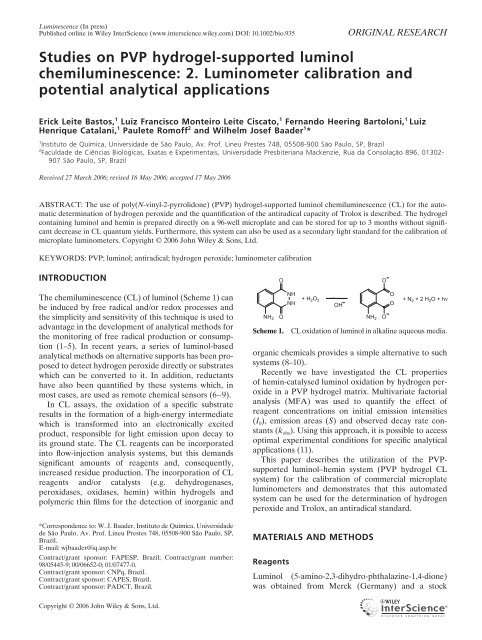
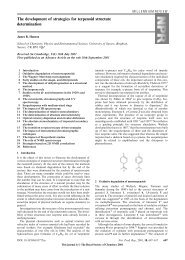
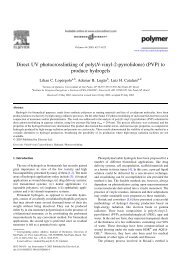
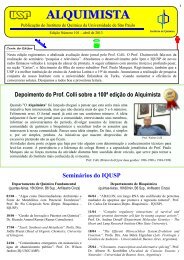
![PE]+ + N. Fragmentação por clivagem sigma](https://img.yumpu.com/50134385/1/180x260/pe-n-fragmentaaao-por-clivagem-sigma.jpg?quality=85)




